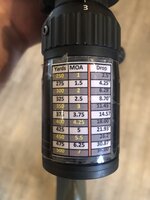FFP/MIL is new to me but going to give it a go to see if I like it. Scope is swfa 3-9. While not really long range I am currently very comfortable out to 600 yards using the shv 3-10 on my main rifle. I currently use a dope card taped to my scope in 25 yard increments. It is updated based on where I’m shooting for elevation and environmentals. I’d like to stick with the same system as it’s simple and fast.
My question is how do guys lay out there dope cards when using mils? With MOA and 25 yard increments I round to the closest .25 moa on my card. It’s not precise but doesn’t negatively effect hitting what I aim at. With mils and a 10 base system the need to round is eliminated since any given yardage has a solution that can be dialed…but it seems that it makes it hard to have a quick reference card in 25 yard increments. I’m not messing with an app solver while hunting. Range, reference dope, dial, shoot is how I need it to be.
Example based on my rifle and cartridge:
400yds is 1.3mils up. 425yds is 1.5mils up. If I ran 25 yard increments on my card do I just accept that between 410-420yds the actual solution is 1.4mil and it’ll be accurate enough?
What are you guys doing for quick reference in MILs?
My question is how do guys lay out there dope cards when using mils? With MOA and 25 yard increments I round to the closest .25 moa on my card. It’s not precise but doesn’t negatively effect hitting what I aim at. With mils and a 10 base system the need to round is eliminated since any given yardage has a solution that can be dialed…but it seems that it makes it hard to have a quick reference card in 25 yard increments. I’m not messing with an app solver while hunting. Range, reference dope, dial, shoot is how I need it to be.
Example based on my rifle and cartridge:
400yds is 1.3mils up. 425yds is 1.5mils up. If I ran 25 yard increments on my card do I just accept that between 410-420yds the actual solution is 1.4mil and it’ll be accurate enough?
What are you guys doing for quick reference in MILs?

